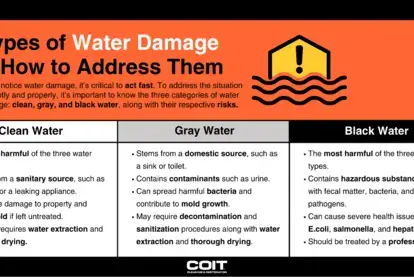
How Colorado Snow Melt Can Impact Your Home's Health
Contact COIT for a professional cleaning!
Homeowners in Colorado get to see some spectacular views, but they also face some big challenges.
While the snow-capped mountains are a beautiful sight in the winter, the Colorado snow melt that follows can be a serious issue for homes.
The link between Colorado snow melt and issues like mold growth and structural damage to homes is more significant than many people realize.
Let’s look at why and how this happens, identify the risks, and discuss the steps you can take to protect your own home from the damage.
The Connection Between Snow Melt and Home Health
As the snow melts, all that water has to go somewhere, and unfortunately, that might be your basement. The spring melting process can quickly lead to basement flooding and moisture intrusion.
When water seeps into homes, it's not just a mess to clean up. Moisture is also a breeding ground for mold and can cause significant structural damage to your interior.
Homes that are located in low-lying areas, are poorly insulated, or were constructed without considering the unique Colorado weather patterns are particularly vulnerable to snow melt.
What month does the snow melt in Colorado?
Typically, the bulk of snow melt in Colorado happens between April and June, depending on exact elevation and local weather conditions.
How Does Colorado Snow Melt Lead to Mold Growth?
Melting snow introduces moisture into homes, creating conditions that favor mold growth.
Dark, damp environments like basements or poorly ventilated areas become breeding grounds for these unwanted guests. As mold spores spread, they threaten the structural integrity of the house and can even introduce mold health risks.
Exposure to mold can lead to respiratory issues, allergies, and other health concerns, especially for those with compromised immune systems.
Preventive Measures for Colorado Homeowners
Remember: being forewarned is being forearmed. By taking preventive measures, you can help reduce the risk of mold growth in your home from snow melt.
Home Insulation
Think of insulation as your home's shield against external elements. Proper insulation acts as a barrier, preventing melting snow from seeping into walls and ceilings.
Check vulnerable areas like your basement and attic and consider upgrading or replacing any worn-out insulation.
Sump Pumps and Proper Drainage
Installing a sump pump can be a game-changer for homes prone to basement flooding.
It helps remove excess water and directs it away from your home’s foundation. Paired with a good drainage system, it can significantly mitigate flooding risks.
Moisture Control and Ventilation
Invest in a dehumidifier to regulate humidity levels in moisture-prone areas in your home. You should also ensure your home is well-ventilated—spaces that breathe are less likely to harbor mold.
Steps and Solutions For Mold Remediation in Colorado
If you think your home might have a mold problem, you need to act quickly. Here's what you can do if you suspect mold has already invaded your space:
Recognizing Early Signs of Mold
Be on the lookout for musty odors, discoloration on walls or ceilings, and any signs of water damage. These often indicate the presence of mold.
Professional vs. DIY Mold Remediation
While minor mold issues can be handled with DIY measures, bigger infestations should be left to the professionals. Companies that deal with mold remediation have the proper tools and expertise to tackle the problem at its root.
Addressing the Root Cause
Mold is a symptom of a bigger issue: moisture. It's important to quickly identify and fix the root cause, whether it’s a leak, poor insulation, or inadequate ventilation.
Economic Implications
Ignoring the signs of mold growth and structural damage from snow melt can be an expensive oversight.
Preventive measures might require an upfront investment but can save you a substantial amount of headaches and money in the long run. It's a clear case of "better safe than sorry."
With proactive measures, regular checks, and a little investment, you can protect your home from the dangers of melting snow in Colorado.
Remember—it's not just about the structure of your home, but the health of its inhabitants, too.
Discover our commercial and residential mold remediation services in Denver.



